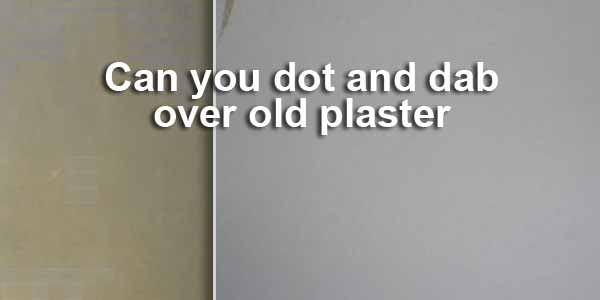Due to various reasons old plaster can deteriorate over time and begin to fail. This could be anything from cracking, blown, or bubbling plaster, to plaster that is completely breaking away. When this happens, it is likely that you will want the problem fixing.
When you do decide to repair old plaster, it can leave you considering your options, such as installing new plasterboards on top of the old surface. This is one of the most common, and easiest ways to make these kinds of repair.

Old plaster is not always in poor condition, sometimes you might simply want to upgrade and improve your walls. So, for example, can you dot and dab over old plaster and what will you need to consider before you start?
There are two potential answers to this question and they both depend on the condition of the old plaster.
- If the old plaster is in sound condition and is not falling away from the wall, then it is possible to dot and dab over it.
- If the old plaster is failing, then you will need to remove it completely and take it back to the old brickwork. This will ensure that you have a solid key and stable surface for the dot and dab to grip.
With a solid fixing, the dot and dab will ensure your plasterboard is held in place firmly and securely.
Is it Better to Remove Old Plaster Before Dot and Dab?
As with all jobs, it is always better to ensure that you carry out the right prep work beforehand. This will ensure that the completed work looks right and will last.
If it is an old property, then it might have old lime-based plaster and lathes. If this is the case, then you will probably need to remove all the old plaster.
There is likely to be moisture in the old plaster, which can cause the dot and dab to soften and fail. Also, it won’t be as structurally strong as modern plasterboards. Therefore, the weight of the new boards could be an issue and pull the old lathe and plaster away from the surface
For modern plaster, it may be showing signs of ageing such as cracking. There could also be blown areas that have come away from the wall. This type of loose plaster will not hold the weight of new dot and dab boards. Therefore, you should avoid dot and dabbing. Instead, you should completely remove all loose plaster before over boarding.
When you dot and dab over old plaster, you should always remember that it will only be as secure as the substrate. If the old plaster is weakened, then your dot and dab will also be weak. This could easily result in the boards pulling the old plaster from the wall.
Just remember to make the surface as secure as possible by removing any loose plaster, then you can dot and dab over. However, there is always a risk that your plasterboards won’t stay on for long if you don’t prep correctly.
What this shows, is you need to make sure the original surface is adequate and can hold the new boards.
Could You Skim Instead of Dot and Dab?
Yes, it is possible to skim on top of old plaster, but there are some things that you will need to consider.
Again, the most important thing is the condition of the old plaster. If it is in good condition, then you will just need to make sure the surface is clean. It’s also possible that old plaster is painted. If so, you will need to sand and clean the surface to provide a better key for new plaster.
Small hairline cracks are usually nothing to worry about. They will just require filling before you skim, or you could use scrim tape to cover them.
It’s very important to make sure that the old plaster is solid, and in good condition, with no blown patches. You should also make sure there is no loose plaster that could fall away with very little pressure.
Once the old plaster has been prepared, you can then coat it using a weak water and PVA solution. If the surface is high suction, you may need to give it two coats. Once the second coat is tacky, you can apply your skim coat. Another option is using a product such as blue grit to provide a good key
When you skim, your best option is to use a multi-finish plaster. This will provide an excellent finish and is suitable when used with a variety of backing surfaces.
One other consideration to make, is the space that you will save if you decide to just re-skim
Dot and dab can add an extra 20 to 30mm to each surface in a room, which would mean a loss of space. In comparison, skimming directly over old plaster would only add around 3mm.
Can You Dot and Dab Over Existing Plasterboard
It is possible to dot and dab over existing plasterboard. However, you will need to make sure that the existing boards are secure. If this is the case, then you can dot and dab straight on top. You will need to consider the weight of the additional plasterboard, so choosing a thinner board, such as 9.5mm will help to reduce weight on the existing dot and dab.
If the existing plasterboard is secured directly to a stud wall, then this makes it even easier. Because the existing boards are screwed to the frame, it will provide a solid and secure base for the dot and dab.
However, in most cases you would also have the option of screwing directly through the existing plasterboard and into the studwork. This would remove the need to use dot and dab, it would be much simpler, and it would save space.
If you have a solid wall next to a stud wall, you can use dot and dab on the solid walls. This will ensure you have a secure and solid finish with the boards securely held in place. You can then also screw the plasterboard to the stud wall ensuring that you have a solid fixing on both surfaces.
Conclusion
Whether you should dot and dab over old plaster will depend on the condition of the existing surface. If it is in good condition and is still firmly in place, then this should not be an issue. However, if there is any sign of weakness or failure, then it will need to be removed back to the brickwork.
You can also skim over existing plaster if the old surface is prepped correctly. Whichever option you choose, it’s important to take care of the prep work to ensure a solid high-quality finish.




